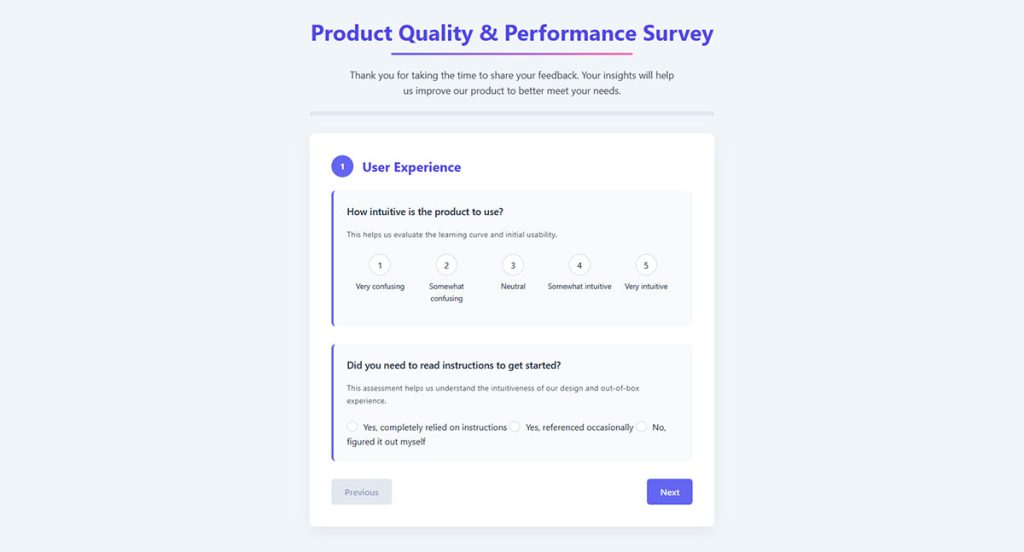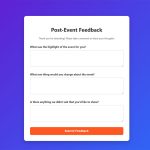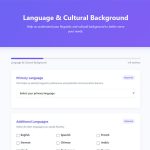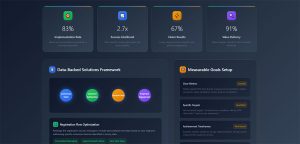One badly worded question can ruin months of research work. Every survey researcher learns this the hard way. Getting good data comes down to picking the right types of survey…
Table of Contents
Getting honest customer feedback can make or break your product’s success. Quality assessment surveys give you direct insight into what customers really think.
Most companies struggle with low response rates and biased feedback. Their questionnaires fail to capture meaningful data about product performance. Meanwhile, competitors use targeted questions to identify quality issues early.
This guide shows you how to craft effective product evaluation questions that get responses. You’ll learn measurement techniques that uncover real customer sentiment. We’ll cover rating scales, open-ended formats, and quality metrics that matter.
By the end, you’ll have templates for:
- Customer satisfaction assessments
- Defect tracking methods
- Product reliability testing
- Feature satisfaction evaluations
These proven question frameworks help you collect actionable quality data. No more guessing about product improvements. Just clear insights from real users.
Survey Questions About Product Quality
Product Usage Experience
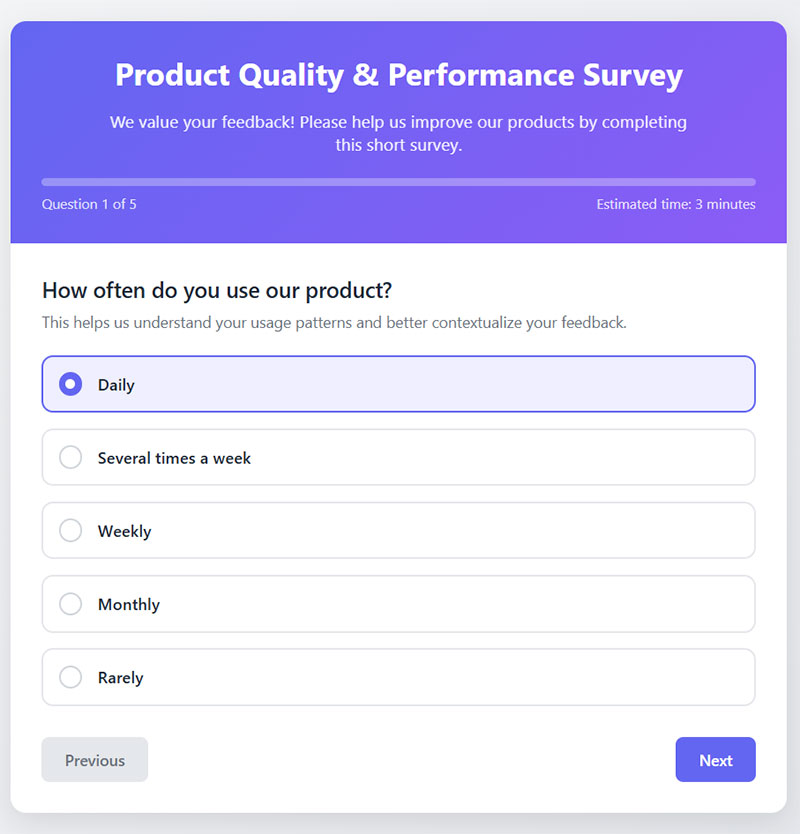
Usage Frequency
Question: How often do you use our product?
Type: Multiple Choice (Daily, Several times a week, Weekly, Monthly, Rarely)
Purpose: Establishes usage patterns to contextualize feedback and segment users by engagement level.
When to Ask: At the beginning of the survey to filter responses or segment analysis.
Feature Utilization
Question: Which features do you use most frequently?
Type: Multiple Selection (List of key product features)
Purpose: Identifies which features provide the most value and which may need improvement or better visibility.
When to Ask: Early in the survey before asking detailed questions about specific features.
Overall Satisfaction Rating
Question: Rate your overall satisfaction with the product performance.
Type: Rating Scale (1-10 from “Completely dissatisfied” to “Extremely satisfied”)
Purpose: Provides a benchmark metric for overall product performance and user sentiment.
When to Ask: Either at the beginning to capture initial impressions or at the end to reflect comprehensive assessment.
Product Appeal
Question: What specifically attracts you to this product?
Type: Open-ended
Purpose: Uncovers unique selling points from the user perspective and reveals unexpected value propositions.
When to Ask: After basic usage questions but before detailed feature evaluations.
Competitive Comparison
Question: How does our product compare to others you’ve tried?
Type: Multiple Choice with comment field (Much worse, Somewhat worse, About the same, Somewhat better, Much better)
Purpose: Gauges competitive positioning and identifies areas where competitors may be outperforming.
When to Ask: Midway through the survey after establishing usage patterns.
Quality Assessment
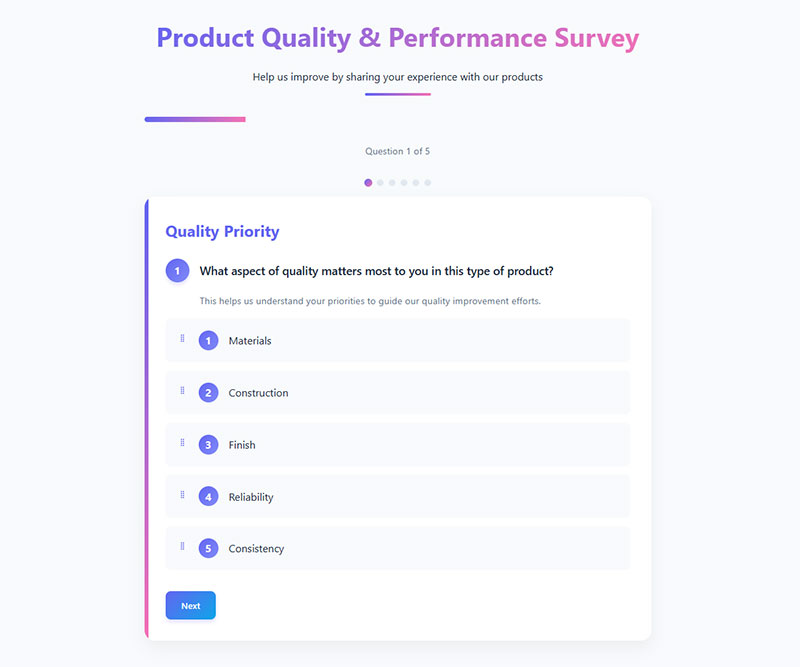
Build Quality Rating
Question: On a scale of 1-10, how would you rate the build quality?
Type: Numeric Scale (1-10)
Purpose: Measures perception of physical construction and materials quality.
When to Ask: During the product quality section of your survey.
Defect Identification
Question: Have you noticed any defects or issues with the product?
Type: Yes/No with comment field for “Yes” responses
Purpose: Identifies specific quality control issues requiring attention.
When to Ask: After general quality questions but before asking about warranty or support experiences.
Durability Assessment
Question: How durable has the product been during your ownership?
Type: Rating Scale (1-5 from “Not at all durable” to “Extremely durable”)
Purpose: Evaluates product longevity and resistance to wear or damage.
When to Ask: After asking about length of ownership and usage frequency.
Expectations Alignment
Question: Does the product meet the quality standards you expected?
Type: Multiple Choice (Falls far short, Falls somewhat short, Meets expectations, Exceeds somewhat, Far exceeds expectations)
Purpose: Measures gap between expected and actual quality, helping identify marketing or messaging issues.
When to Ask: Midway through the survey after establishing usage context.
Quality Priority
Question: What aspect of quality matters most to you in this type of product?
Type: Ranking or Multiple Choice (Materials, Construction, Finish, Reliability, Consistency)
Purpose: Reveals user priorities to guide quality improvement efforts.
When to Ask: Near the beginning of the quality assessment section.
Performance Evaluation
Marketing Claims Verification
Question: Does the product perform as advertised?
Type: Likert Scale (Strongly disagree to Strongly agree)
Purpose: Validates marketing claims and identifies potential areas of overpromising.
When to Ask: After establishing familiarity with the product.
Strength Identification
Question: What tasks does the product handle well?
Type: Open-ended or Multiple Selection
Purpose: Identifies core competencies and primary use cases from user perspective.
When to Ask: During the performance section after general performance questions.
Performance Gaps
Question: Where does the product fall short in performance?
Type: Open-ended
Purpose: Reveals performance weaknesses and opportunities for improvement.
When to Ask: After asking about strengths to encourage balanced feedback.
Performance Evolution
Question: Has the product’s performance changed over time?
Type: Multiple Choice with comment field (Significantly worse, Somewhat worse, No change, Somewhat better, Significantly better)
Purpose: Tracks performance degradation or improvement through product lifecycle.
When to Ask: Only after establishing moderate to long-term usage.
Desired Improvements
Question: What performance improvements would make this product better for you?
Type: Open-ended
Purpose: Gathers specific improvement suggestions directly related to user needs.
When to Ask: Near the end of the performance section after evaluating current capabilities.
Reliability & Consistency
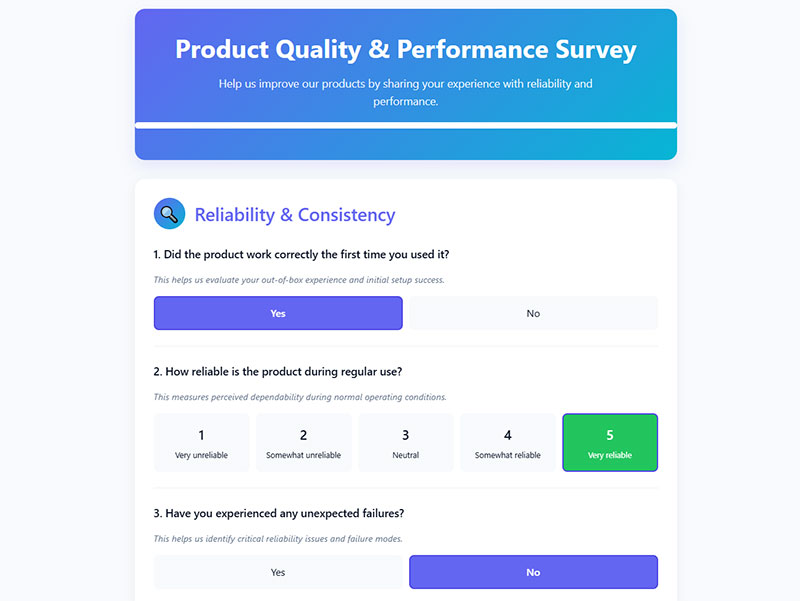
First-Use Success
Question: Did the product work correctly the first time you used it?
Type: Yes/No with comment field for “No” responses
Purpose: Evaluates out-of-box experience and initial setup success.
When to Ask: When surveying newer customers or asking about onboarding experiences.
Operational Reliability
Question: How reliable is the product during regular use?
Type: Rating Scale (1-5 from “Very unreliable” to “Very reliable”)
Purpose: Measures perceived dependability during normal operating conditions.
When to Ask: After establishing usage patterns.
Failure Experience
Question: Have you experienced any unexpected failures?
Type: Yes/No with details field for “Yes” responses
Purpose: Identifies critical reliability issues and failure modes.
When to Ask: After general reliability questions but before asking about support experiences.
Consistency Assessment
Question: Does the product perform consistently each time you use it?
Type: Likert Scale (Never to Always)
Purpose: Evaluates performance predictability and consistency across usage sessions.
When to Ask: After questions about usage frequency and patterns.
Trust Enhancement
Question: What would make you trust this product more?
Type: Open-ended
Purpose: Reveals trust barriers and opportunities to build confidence in the product.
When to Ask: Near the end of the reliability section after identifying any issues.
Value Assessment
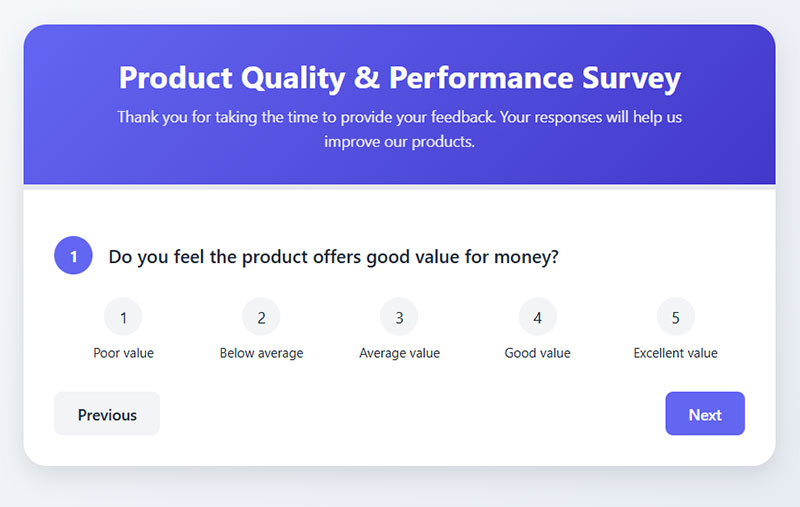
Value Perception
Question: Do you feel the product offers good value for money?
Type: Rating Scale (1-5 from “Poor value” to “Excellent value”)
Purpose: Measures price-to-value relationship from user perspective.
When to Ask: After performance and quality questions to ensure context for value judgment.
Repurchase Intent
Question: Would you purchase this product again at its current price point?
Type: Multiple Choice (Definitely not, Probably not, Unsure, Probably yes, Definitely yes)
Purpose: Indicates overall satisfaction and perceived value relative to cost.
When to Ask: Near the end of the survey after comprehensive product evaluation.
Competitive Pricing
Question: How does our pricing compare to the quality delivered?
Type: Multiple Choice (Overpriced, Slightly overpriced, Fairly priced, Good deal, Excellent value)
Purpose: Evaluates price positioning relative to quality perception.
When to Ask: After quality assessment questions.
Value-Added Features
Question: What additional features would justify a higher price?
Type: Open-ended
Purpose: Identifies potential premium features for upselling or new product development.
When to Ask: After asking about current features and pricing perception.
Recommendation Likelihood
Question: Would you recommend this product to friends based on its value?
Type: Rating Scale (0-10, Net Promoter Score format)
Purpose: Measures advocacy potential based specifically on value proposition.
When to Ask: Near the end of the survey after comprehensive evaluation.
User Experience
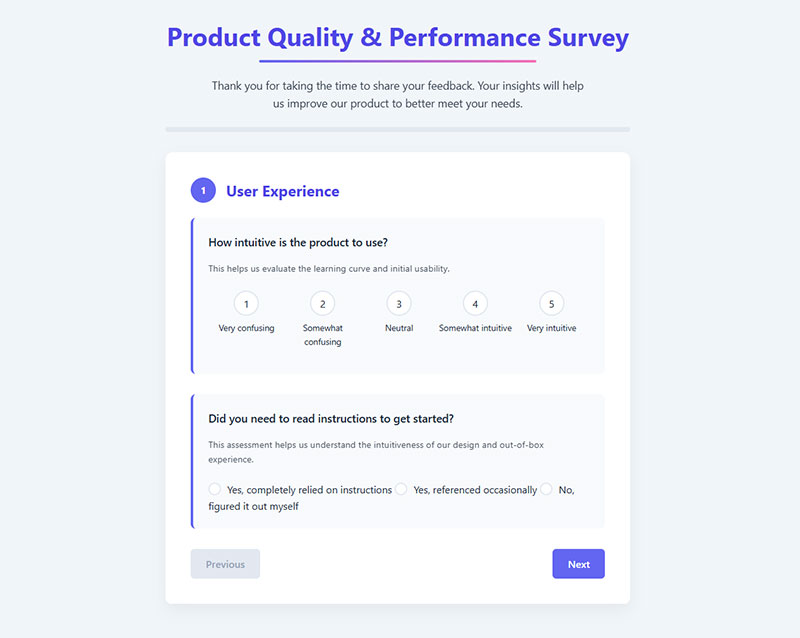
Intuitive Design
Question: How intuitive is the product to use?
Type: Rating Scale (1-5 from “Very confusing” to “Very intuitive”)
Purpose: Evaluates learning curve and initial usability.
When to Ask: Early in the user experience section.
Instructions Necessity
Question: Did you need to read instructions to get started?
Type: Multiple Choice (Yes, completely relied on instructions; Yes, referenced occasionally; No, figured it out myself)
Purpose: Assesses intuitiveness of design and out-of-box experience.
When to Ask: When evaluating onboarding or initial setup experience.
Pain Points
Question: What frustrations have you experienced while using the product?
Type: Open-ended
Purpose: Identifies friction points and usability issues requiring attention.
When to Ask: After general usability questions but before asking about specific features.
Joy Points
Question: Which aspects of using the product bring you the most joy?
Type: Open-ended
Purpose: Reveals emotional connections and highlights features that create positive experiences.
When to Ask: After asking about frustrations to balance the feedback.
Usability Improvement
Question: How could we make the product easier to use?
Type: Open-ended
Purpose: Gathers specific suggestions for usability enhancements.
When to Ask: Near the end of the user experience section after identifying any issues.
Specific Performance Metrics
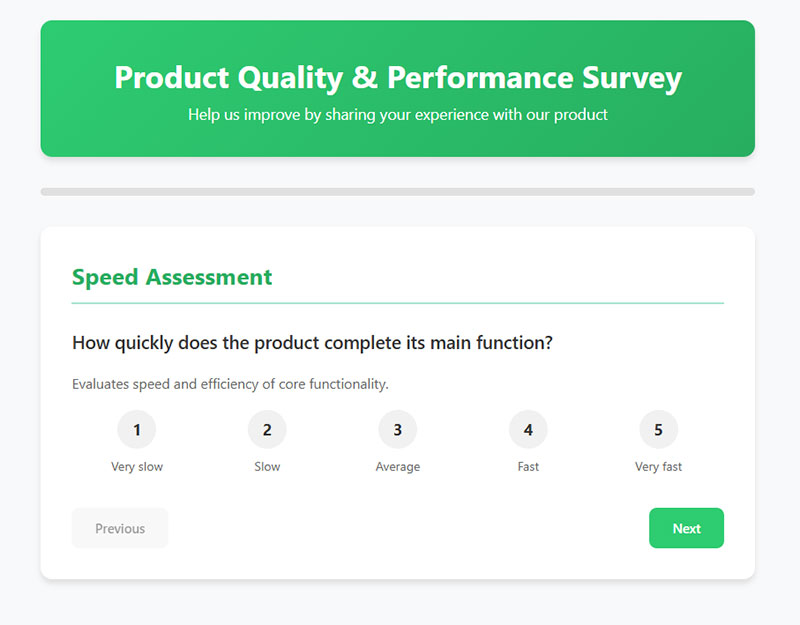
Speed Assessment
Question: How quickly does the product complete its main function?
Type: Rating Scale (1-5 from “Very slow” to “Very fast”)
Purpose: Evaluates speed and efficiency of core functionality.
When to Ask: During the performance metrics section.
Performance Under Load
Question: Does the product maintain consistent performance under heavy use?
Type: Multiple Choice (Performance significantly drops, Slight performance decrease, Maintains consistent performance)
Purpose: Identifies performance degradation under stress conditions.
When to Ask: Only relevant for users who have indicated heavy usage patterns.
Edge Case Handling
Question: How has the product handled unexpected situations?
Type: Open-ended
Purpose: Evaluates resilience and adaptability to nonstandard use cases.
When to Ask: After establishing familiarity with normal usage patterns.
Efficiency Rating
Question: Rate the product’s energy efficiency or battery life.
Type: Rating Scale (1-5 from “Poor” to “Excellent”)
Purpose: Measures resource consumption and operational efficiency.
When to Ask: Relevant for electronic or powered products.
Performance Bottlenecks
Question: What performance bottlenecks have you identified?
Type: Open-ended
Purpose: Discovers specific performance limitations from power users.
When to Ask: Best directed at experienced users who have used the product extensively.
Improvement Suggestions
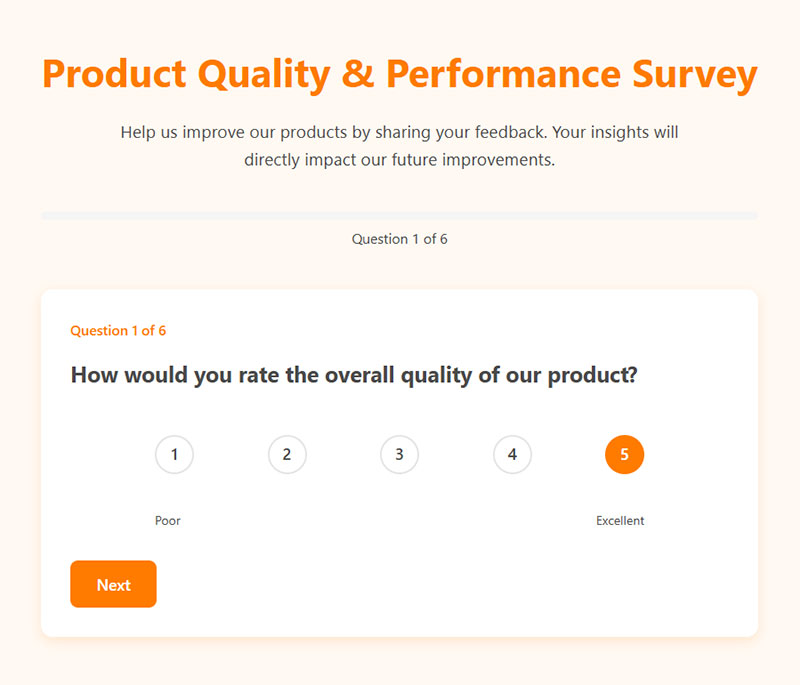
Primary Improvement Area
Question: What one thing would you improve about this product?
Type: Open-ended
Purpose: Forces prioritization of the most critical improvement need.
When to Ask: Near the end of the survey after comprehensive evaluation.
Feature Request
Question: Which additional feature would most increase your satisfaction?
Type: Open-ended or Multiple Choice based on product roadmap options
Purpose: Identifies high-impact feature additions for future development.
When to Ask: After evaluating current features.
Quality Issue Priority
Question: What quality issues need immediate attention?
Type: Open-ended
Purpose: Highlights critical quality concerns requiring urgent fixes.
When to Ask: After quality assessment questions.
Longevity Enhancement
Question: How could we enhance the product’s longevity?
Type: Open-ended
Purpose: Gathers ideas for improving product lifespan and durability.
When to Ask: After durability and reliability questions.
Upgrade Triggers
Question: What performance upgrades would make you upgrade to a newer version?
Type: Open-ended or Multiple Selection from potential upgrade options
Purpose: Identifies compelling features for product roadmap and future versions.
When to Ask: Near the end of the survey to capture forward-looking insights.
FAQ on Survey Questions About Product Quality
What types of questions work best for measuring product quality?
Multiple choice questions and Likert scale ratings capture quantitative data effectively. Add open-ended responses for context. Mix rating scale questions with specific quality attribute assessments.
How many questions should a product quality survey include?
Keep surveys between 10-15 questions. Focus on key quality metrics. Longer surveys reduce completion rates. Prioritize essential customer satisfaction indicators over comprehensive coverage.
What’s the ideal response scale for quality surveys?
Use 5-point or 7-point scales. Both provide good satisfaction measurement balance. Odd numbers allow neutral responses. The Net Promoter Score uses an 11-point scale successfully.
When should I conduct product quality surveys?
Send post-purchase survey questions within 2-4 weeks. This captures fresh experiences while avoiding immediate reaction bias. Regular quarterly assessments track quality trends effectively.
How do I increase survey response rates?
Offer incentives. Keep surveys short. Use mobile forms. Send personalized invitations. Time emails strategically. Clear subject lines boost opens by 30%.
Which quality aspects should surveys measure?
Cover durability, functionality, design, and value. Include customer effort score questions. Assess warranty claim likelihood. Ask about recommendation probability to gauge overall satisfaction levels effectively.
Should I use anonymous or identified surveys?
Anonymous surveys generate honest feedback. Identified responses allow follow-up. Consider both approaches. GDPR compliant forms must respect privacy choices regardless of format selection.
How do I analyze quality survey data?
Calculate averages for ratings. Identify response patterns. Compare segments using satisfaction trend analysis. Track scores over time. Focus on actionable improvement areas first.
What tools can create effective quality surveys?
Platforms like Qualtrics offer advanced features. Google Forms provides free basics. SurveyMonkey balances functionality and cost. Choose based on analysis needs and budget constraints.
How often should I update survey questions?
Review questions quarterly. Update when products change significantly. Test new formats regularly. Keep core quality benchmarking standards consistent for trend tracking accuracy.
Conclusion
Effective survey questions about product quality drive real business improvements. Quality monitoring systems rely on well-designed questionnaires to capture actionable insights. The right question formats transform raw feedback into measurable outcomes.
Remember key principles. Short surveys boost response rate optimization. Mix quantitative scales with qualitative inputs. Test questions before full deployment. Update regularly based on product changes.
Your customer research methodology should balance:
- Simplicity for respondents
- Depth for analysis
- Consistency for tracking
Strong quality surveys become competitive advantages. Companies like J.D. Power built reputations on systematic feedback collection. Your surveys can achieve similar impact with proper design.
Start implementing these strategies today. Choose appropriate survey form templates for your industry. Monitor quality improvement measures quarterly. Let customer voices guide product evolution.
Quality surveys aren’t just data collection tools. They’re bridges between customer needs and product excellence. Build yours thoughtfully.
